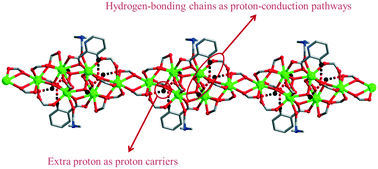High proton conduction behavior in 12-connected 3D porous lanthanide–organic frameworks and their polymer composites†
Abstract
Two novel lanthanide–organic frameworks, {[Ln3(bpydb)3(HCOO)(OH)2(DMF)]·3DMF·xH2O}n (Ln = Eu3+ (1) and x = 2; Tb3+ (2) and x = 1; bpydbH2 is 4,4′-(4,4′-bipyridine-2,6-diyl) dibenzoic acid; DMF denotes N,N′-dimethylformamide), have been synthesized and structurally characterized. Topological analysis reveals that 1 and 2 are 12-connected frameworks with an fcu topology, which are based on rod-shaped {Ln6} as 12-connected nodes. AC impedance analysis shows that the proton conductivity of 1 and 2 reaches up to 1.7 × 10−4 S cm−1 at 325 K and 1.1 × 10−4 S cm−1 at 334 K, respectively, under 98% RH. Furthermore, the polymer composite membranes of poly(vinyl alcohol) (PVA) and 1 or 2 as fillers with different mass percentages (X%, with the composite membrane denoted as 1@PVA-X or 2@PVA-X) were fabricated. The proton conductivities of both 1@PVA-10 and 2@PVA-10 are higher than those of 1 and 2 under the same conditions, which can be interpreted that the PVA polymer can provide a continuous proton transfer pathway for 1 and 2. To the best of our knowledge, it is the first composite based on Ln–MOFs and a polymer as proton exchange membranes. This research may contribute to the further development of Ln–MOFs in the field of proton exchange membranes in fuel cells.



 Please wait while we load your content...
Please wait while we load your content...